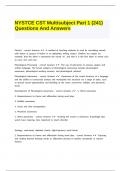NYSTCE CST Multisubject Part 1 (241)
Questions And Answers
Phonics \- \correct \Answers \✔✔ \-A \method \of \teaching \students \to \read \by \correlating \sounds \
with \letters \or \groups \of \letters \in \an \alphabetic \writing \system. \Children \are \taught, \for \
example, \that \the \letter \n \represents \the \sound \/n/, \and \that \it \is \the \first \letter \in \words \such \
as \nose, \nice \and \new.
Phonological \Processing \- \correct \Answers \✔✔ \-The \use \of \phonemes \to \process \spoken \and \
written \language. \The \broad \category \of \phonological \processing \includes \phonological \
awareness, \phonological \working \memory, \and \phonological \retrieval.
Phonological \Awareness \- \correct \Answers \✔✔ \-Awareness \of \the \sound \structure \of \a \language \
and \the \ability \to \consciously \analyze \and \manipulate \this \structure \via \a \range \of \tasks, \such \
as \speech \sound \segmentation \and \blending \at \the \word, \onset-rime, \syllable, \and \phonemic \
levels.
Development \of \Phonological \Awareness \- \correct \Answers \✔✔ \-1. \Word \awareness
2. \Responsiveness \to \rhyme \and \alliteration \during \word \play
3. \Syllable \awareness
4. \Onset \and \rime \manipulation
5. \Phoneme \awareness
1. \Word \awareness \- \correct \Answers \✔✔ \-Tracking \the \words \in \sentences. \Knowledge \that \
words \have \meaning. \(less \important \to \teach \directly)
Strategy: \read-aloud, \alphabet \chants, \high-frequency \word \books
2. \Responsiveness \to \rhyme \and \alliteration \during \word \play \- \correct \Answers \✔✔ \-Enjoying \
and \reciting \learned \rhyming \words \or \alliterative \phrases \in \familiar \storybooks \or \nursery \
rhymes. \
,Strategy: \poetry \books, \alphabet \chants, \picture \flashcards \w/ \objects \whose \names \rhyme.
(Flashcards \can \be \used \in \sorting \and \classifying \activities.)
3. \Syllable \awareness \- \correct \Answers \✔✔ \-Counting, \tapping, \blending, \or \segmenting \a \word \
into \syllables.
Strategy: \Flashcards \w/ \objects \whose \names \contain \different \numbers \of \syllables.
(Flashcards \can \be \used \in \sorting \activity.)
4. \Onset \and \rime \manipulation \- \correct \Answers \✔✔ \-Onset \is \the \initial \consonant \in \a \one-
syllable \word. \Rime \includes \the \remaining \sounds, \including \the \vowel \and \any \sounds \that \
follow. \The \ability \to \produce \a \rhyming \word \depends \on \understanding \that \rhyming \words \
have \the \same \rime. \Recognizing \a \rhyme \is \much \easier \than \producing \a \rhyme.
Strategy: \Blending \and \substitution \activities.
5. \Phonemic \awareness \- \correct \Answers \✔✔ \-This \is \the \student's \awareness \of \the \smallest \
units \of \sound \in \a \word. \It \also \refers \to \a \student's \ability \to \segment, \blend, \and \manipulate \
these \units.
- \Identify \and \match \the \initial \sounds \in \words, \then \the \final \and \middle \sounds \(e.g., \"Which \
picture \begins \with \/m/?"; \"Find \another \picture \that \ends \in \/r/").
- \Segment \and \produce \the \initial \sound, \then \the \final \and \middle \sounds \(e.g., \"What \sound \
does \zoo \start \with?"; \"Say \the \last \sound \in \milk"; \"Say \the \vowel \sound \in \rope").
- \Blend \sounds \into \words \(e.g., \"Listen: \/f/ \/ē/ \/t/. \Say \it \fast").
, - \Segment \the \phonemes \in \two- \or \three-sound \words, \moving \to \four- \and \five- \sound \words \
as \the \student \becomes \proficient \(e.g., \"The \word \is \eyes. \Stretch \and \say \the \sounds: \/ī/ \/z/").
- \Manipulate \phonemes \by \removing, \adding, \or \substituting \sounds \(e.g., \"Say \smoke \without \
the \/m/").
Strategy: \listening \to \alliterative \passages, \blending \and \segmenting \words, \and \manipulating \
sounds \in \words \through \substitution, \deletion, \and \addition \of \phonemics. \Elkonin \boxes \are \
provided \for \tactile \blending \and \segmenting \activities.
Phonological \Working \Memory \- \correct \Answers \✔✔ \-Involves \storing \phoneme \information \in \
a \temporary, \short-term \memory \store. \This \phonemic \information \is \then \readily \available \for \
manipulation \during \phonological \awareness \tasks.
Phonological \Retrieval \- \correct \Answers \✔✔ \-Phonological \retrieval \is \the \ability \to \recall \the \
phonemes \associated \with \specific \graphemes, \which \can \be \assessed \by \rapid \naming \tasks.
Phoneme \Manipulation \Task \(Strategy) \- \correct \Answers \✔✔ \-Tasks \that \tap \into \phonological \
processing, \such \as \phoneme \manipulation \tasks \(say \"cat" \without \the \kuh), \have \proven \to \be \
some \of \the \strongest \correlates \and \predictors \of \learning \to \read.
Orthographic \Processing \- \correct \Answers \✔✔ \-Defined \as \"the \ability \to \form, \store, \and \access
\orthographic \representations." \Orthography \is \the \methodology \of \writing \a \language, \which \
primarily \consists \of
spelling, \but \includes, \contractions, \punctuation \and \capitalization.
Semantic \Processing \- \correct \Answers \✔✔ \-Encode \the \meaning \of \a \word \and \relate \it \to \
similar \words \with \similar \meaning.
Syntactic \Processing \- \correct \Answers \✔✔ \-The \order \and \arrangement \of \words \in \phrases \
and \sentences; \you \might \depend \in \part \on \syntactic \processing \to \know \the \difference \
between \"The \cat \is \on \the \mat" \and \"The \mat \is \on \the \cat."
Discourse \Processing \- \correct \Answers \✔✔ \-Focus \on \the \ways \in \which \readers \and \listeners \
comprehend \language.
Development \of \Oral \Language \- \correct \Answers \✔✔ \-1. \Cooing
2. \Babbling
3. \One-Word \Stage




